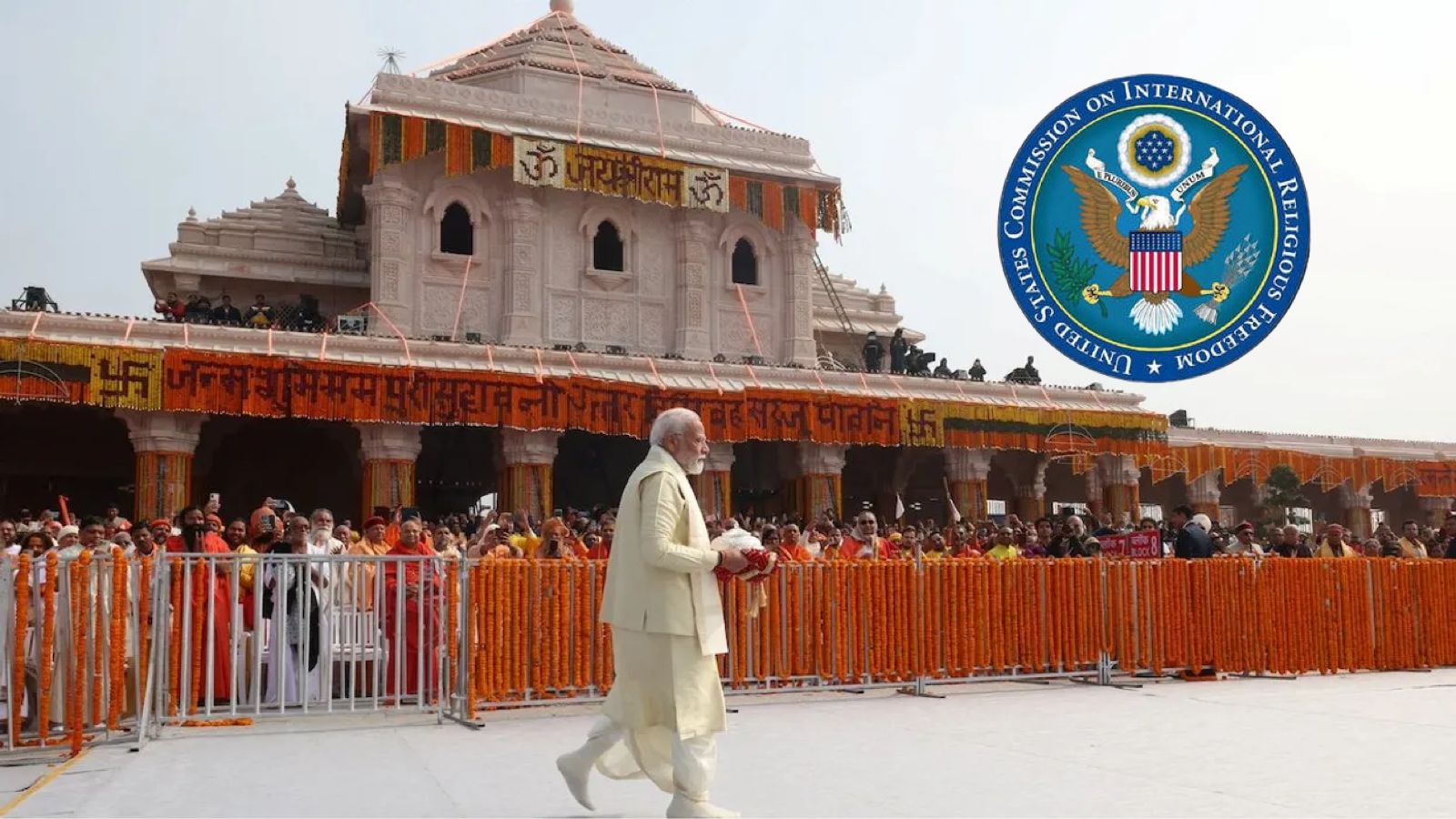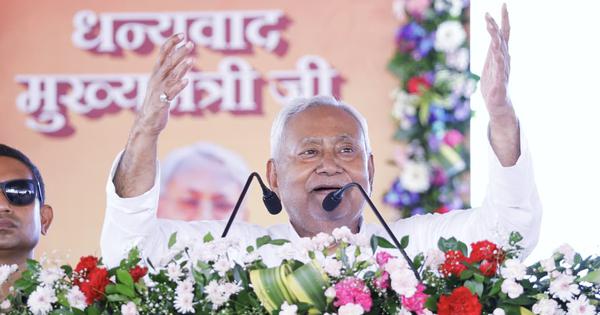Ram Mandir-Babri dispute, bulldozer justice, Delhi riots, and more: Decoding USCIRF’s 2025 Report and its multi-year campaign against India, especially Hindus
Each year, the United States Commission on International Religious Freedom (USCIRF) releases what it calls an “independent assessment” of global religious freedom. In practice, the report functions less like a neutral evaluation and more like a geopolitical cudgel, selectively deployed against nations that refuse to conform to the organisation’s ideological preferences or America’s fluctuating strategic priorities. India, a civilisational democracy of 1.4 billion people, has long been a favourite target. Predictably, this year too, the USCIRF placed India under “Countries of Particular Concern” and even recommended a review of U.S. arms sales. The political motivations are transparent: Washington is displeased with India’s oil purchases from Russia, a position dripping with hypocrisy, considering the United States itself continues trade with Moscow. Into this environment arrives USCIRF’s 2025 report, a document remarkable not for insight, but for its distortions. Ram Mandir: USCIRF’s deliberate historical erasure The most startling example is its description of the Ram Mandir consecration ceremony in Ayodhya. The report claims that PM Modi inaugurated a temple “built on the ruins of the Babri Masjid,” as if the event were an act of majoritarian triumphalism rather than the lawful culmination of a centuries-old dispute resolved by India’s Supreme Court. This portrayal conveniently omits all archaeological and historical evidence that the Babri structure had been raised atop an earlier Hindu temple, a fact documented by the Archaeological Survey of India’s extensive excavations and corroborated by British-era records in the National Archives of India, which openly referred to the site as “Masjid-i-Janmasthan.” Even after Mughal encroachment, Hindus continued to worship at the spot, preserving its identity as Shri Ram’s birthplace. The 2019 Supreme Court verdict, delivered after decades of hearings, weighed all evidence before awarding the land to the Hindu claimants. For USCIRF to insinuate wrongdoing in a ceremony conducted pursuant to that judgment amounts to a casual dismissal of India’s constitutional institutions. Is the organisation suggesting that a democratically elected government and a unanimous Supreme Court are incapable of adjudicating their own domestic disputes? Or does USCIRF believe it possesses superior civilisational and historical knowledge? Whitewashing the Delhi riots: Turning extremists into peaceful protesters The report next attempts to rewrite the events of the 2020 Delhi riots. It claims that Umar Khalid, Sharjeel Imam and Meeran Haider were imprisoned merely for “peacefully protesting” the Citizenship Amendment Act (CAA). This characterisation is not only false but fundamentally dishonest. The violence that engulfed Delhi in February 2020, killing more than 50 people and injuring hundreds, was not a spontaneous outburst by peaceful demonstrators. It was a coordinated attack deliberately staged during a high-profile diplomatic visit to embarrass the Indian state. Umar Khalid has been identified as a key conspirator, with the chargesheet containing transcripts, mobilisation evidence, and testimonies revealing an organised plot. Sharjeel Imam’s recorded speech calling for the blockade of the Siliguri Corridor, India’s vulnerable “Chicken Neck”, shows the secessionist impulse underlying his activism. To describe these men as benign protesters is to insult the victims of the riots and to reveal USCIRF’s eagerness to rehabilitate individuals whose actions fall far outside the realm of peaceful dissent. The bulldozer lie: Distorting law enforcement as communal persecution Equally misleading is USCIRF’s accusation that India “demolished Muslim-owned properties, including mosques, deemed illegal.” This framing is divorced from reality. Demolition drives across multiple states, from Delhi to Madhya Pradesh to Uttarakhand, targeted illegal encroachments constructed on public land, riverbeds, pavements and government-owned plots. These were not actions driven by faith or identity but by the need to enforce land-use norms and public safety. In some instances, mosque committees themselves admitted that parts of certain structures were built on encroached land and even volunteered to remove them. The USCIRF narrative transforms routine civic enforcement into a communal conspiracy, conveniently ignoring the legal and administrative realities that apply uniformly regardless of religion. Anti-conversion laws: USCIRF’s refusal to acknowledge ground realities The report’s attack on anti-conversion laws reveals similar ideological rigidity. These laws, enacted by states from across the political spectrum, seek to curb fraudulent, coercive or inducement-based conversions, practices widely documented in FIRs and testimonies across several regions. India’s anti-conversion laws do not prohibit voluntary change of faith; they regulate coercion, fraud and e



Each year, the United States Commission on International Religious Freedom (USCIRF) releases what it calls an “independent assessment” of global religious freedom. In practice, the report functions less like a neutral evaluation and more like a geopolitical cudgel, selectively deployed against nations that refuse to conform to the organisation’s ideological preferences or America’s fluctuating strategic priorities. India, a civilisational democracy of 1.4 billion people, has long been a favourite target.
Predictably, this year too, the USCIRF placed India under “Countries of Particular Concern” and even recommended a review of U.S. arms sales. The political motivations are transparent: Washington is displeased with India’s oil purchases from Russia, a position dripping with hypocrisy, considering the United States itself continues trade with Moscow. Into this environment arrives USCIRF’s 2025 report, a document remarkable not for insight, but for its distortions.
Ram Mandir: USCIRF’s deliberate historical erasure
The most startling example is its description of the Ram Mandir consecration ceremony in Ayodhya. The report claims that PM Modi inaugurated a temple “built on the ruins of the Babri Masjid,” as if the event were an act of majoritarian triumphalism rather than the lawful culmination of a centuries-old dispute resolved by India’s Supreme Court.
This portrayal conveniently omits all archaeological and historical evidence that the Babri structure had been raised atop an earlier Hindu temple, a fact documented by the Archaeological Survey of India’s extensive excavations and corroborated by British-era records in the National Archives of India, which openly referred to the site as “Masjid-i-Janmasthan.” Even after Mughal encroachment, Hindus continued to worship at the spot, preserving its identity as Shri Ram’s birthplace.
The 2019 Supreme Court verdict, delivered after decades of hearings, weighed all evidence before awarding the land to the Hindu claimants. For USCIRF to insinuate wrongdoing in a ceremony conducted pursuant to that judgment amounts to a casual dismissal of India’s constitutional institutions. Is the organisation suggesting that a democratically elected government and a unanimous Supreme Court are incapable of adjudicating their own domestic disputes? Or does USCIRF believe it possesses superior civilisational and historical knowledge?
Whitewashing the Delhi riots: Turning extremists into peaceful protesters
The report next attempts to rewrite the events of the 2020 Delhi riots. It claims that Umar Khalid, Sharjeel Imam and Meeran Haider were imprisoned merely for “peacefully protesting” the Citizenship Amendment Act (CAA). This characterisation is not only false but fundamentally dishonest.
The violence that engulfed Delhi in February 2020, killing more than 50 people and injuring hundreds, was not a spontaneous outburst by peaceful demonstrators. It was a coordinated attack deliberately staged during a high-profile diplomatic visit to embarrass the Indian state. Umar Khalid has been identified as a key conspirator, with the chargesheet containing transcripts, mobilisation evidence, and testimonies revealing an organised plot.
Sharjeel Imam’s recorded speech calling for the blockade of the Siliguri Corridor, India’s vulnerable “Chicken Neck”, shows the secessionist impulse underlying his activism. To describe these men as benign protesters is to insult the victims of the riots and to reveal USCIRF’s eagerness to rehabilitate individuals whose actions fall far outside the realm of peaceful dissent.
The bulldozer lie: Distorting law enforcement as communal persecution
Equally misleading is USCIRF’s accusation that India “demolished Muslim-owned properties, including mosques, deemed illegal.” This framing is divorced from reality. Demolition drives across multiple states, from Delhi to Madhya Pradesh to Uttarakhand, targeted illegal encroachments constructed on public land, riverbeds, pavements and government-owned plots. These were not actions driven by faith or identity but by the need to enforce land-use norms and public safety.
In some instances, mosque committees themselves admitted that parts of certain structures were built on encroached land and even volunteered to remove them. The USCIRF narrative transforms routine civic enforcement into a communal conspiracy, conveniently ignoring the legal and administrative realities that apply uniformly regardless of religion.
Anti-conversion laws: USCIRF’s refusal to acknowledge ground realities
The report’s attack on anti-conversion laws reveals similar ideological rigidity. These laws, enacted by states from across the political spectrum, seek to curb fraudulent, coercive or inducement-based conversions, practices widely documented in FIRs and testimonies across several regions.
India’s anti-conversion laws do not prohibit voluntary change of faith; they regulate coercion, fraud and exploitation of vulnerable populations. Moreover, the federal structure of the Indian governmental model offers states to frame their own laws to deal with specific menaces, including the scourge of religious conversions, which have increased dramatically with the use of newer deceptive methods by missionaries to entrap unsuspecting and vulnerable sections of the society.
Yet USCIRF reduces this complex social phenomenon to an “anti-minority” campaign, choosing to ignore testimonies from victims of conversion rackets and the widespread concerns expressed by communities themselves. This signals a refusal to engage with India on its own lived social realities.
Cow protection: USCIRF’s willing blindness to cultural context
Its criticism of cow protection laws reflects the same unwillingness to acknowledge cultural context. The cow holds both civilisational and constitutional significance in India, with the Constitution’s Directive Principles calling for its protection. Just as Western societies regulate or forbid the consumption of culturally sensitive animals, whether horses, dogs, or whales, India’s cow protection laws are a reflection of long-standing societal ethos. But USCIRF’s ideological lens does not permit such nuance. Instead, it mechanically classifies these laws as expressions of majoritarian oppression, revealing more about its cultural incomprehension than about India.
A report driven by ideology, not evidence
The fundamental weakness of the 2025 USCIRF report lies not simply in its factual errors but in the worldview that shapes it. Year after year, the commission mirrors U.S. foreign-policy anxieties, criticising nations that assert strategic autonomy while overlooking rights violations by America’s favoured partners. Its analysis of India reads not like a neutral evaluation but like an ideological mandate drafted by activists who neither understand nor respect India’s pluralistic civilisation. It demands that India conform to American models of secularism, ignoring the reality that Indian secularism is premised on equal respect for all faiths, not forced invisibilisation of the majority.
What the report offers is not a survey of religious liberty but a political text wielded with increasing clumsiness. It attempts to delegitimise India’s courts, elected institutions, and law-enforcement mechanisms through selective outrage and motivated framing. In the name of protecting religious freedom, USCIRF ends up undermining the sovereignty and cultural rights of one of the most diverse democracies in the world.
How the 2024 and 2023 reports reveal USCIRF’s multi-year propaganda campaign
The 2025 report does not stand alone. It is the newest chapter in a multi-year pattern of targeted hostility, made evident in the 2024 and 2023 USCIRF and State Department reports.
The 2024 report followed the same formula. It claimed that India’s religious freedom was “deteriorating,” repeated allegations about hate speech during elections, and recycled the bulldozer, anti-conversion, and cow-slaughter narratives. It even recommended classifying India as a “Country of Particular Concern” and floated the idea of sanctions, precisely what the 2025 report now amplifies. India rejected that report in its entirety, stating that USCIRF was operating with a preconceived political agenda rather than a human-rights mandate.
India’s reaction to the 2023 report was even more explicit. In June 2024, MEA spokesperson Randhir Jaiswal condemned the document as “deeply biased,” “vote-bank driven,” and an exercise steeped in “misrepresentation, imputations and selective use of facts.” He pointed out that the report went so far as to question the validity of India’s constitutional provisions, laws, and even Supreme Court judgments, a level of overreach that no sovereign democracy can accept. Jaiswal also highlighted USCIRF’s hypocrisy in criticising India’s FCRA and foreign-funding norms when the United States itself enforces even stricter regulations.
He reminded Washington that while the U.S. lectures India on hate crimes and religious freedom, the Indian government has repeatedly documented racial attacks, temple vandalisation, hate crimes against Indian-origin citizens, and police excesses inside the United States itself, none of which USCIRF has ever meaningfully addressed. That silence speaks volumes.
Viewed together, the 2023, 2024 and 2025 reports demonstrate a consistent pattern. USCIRF relies on the same fringe activists, riot-accused individuals, separatist sympathisers, and Maoist-linked personalities as its “victims.” It repeats the same allegations with minimal variation year-to-year. It frames India’s legal and cultural landscape through an ideological lens imported from American academia. And it attempts to weaponise the CPC designation as a diplomatic tool rather than offer a nuanced or factual assessment.
The years-long campaign of vilifying India
The 2025 USCIRF report is not simply biased; it is the culmination of a years-long campaign to frame India as a violator of religious rights irrespective of evidence or judicial fact. When an organisation repeatedly recycles the same allegations, relies on discredited sources, ignores court verdicts, and disregards cultural context, the problem lies not in the country being assessed, but in the assessor.
USCIRF is not documenting religious freedom in India. It is manufacturing a narrative. And it’s credibility is as low as the IQ of a popular opposition leader in India.





































































